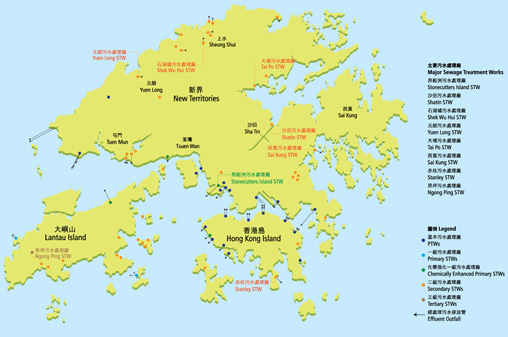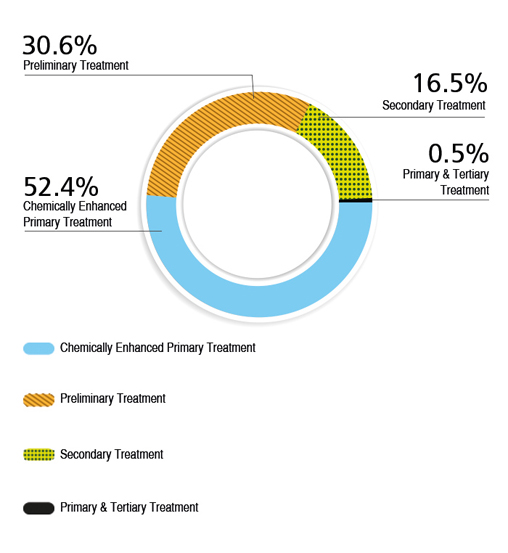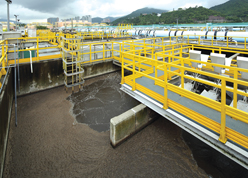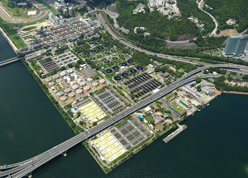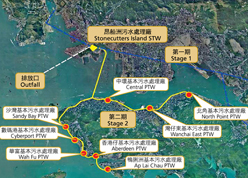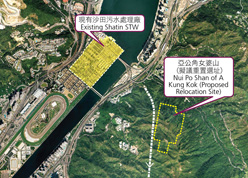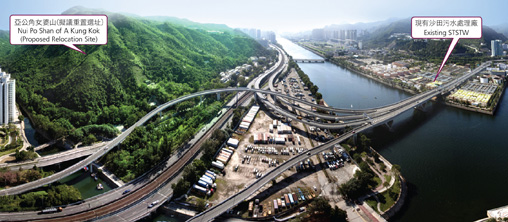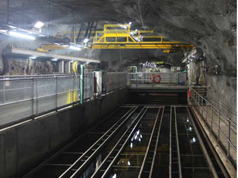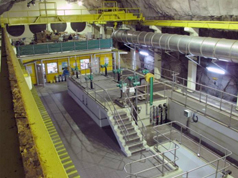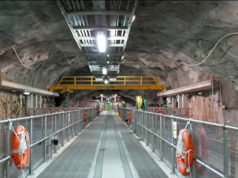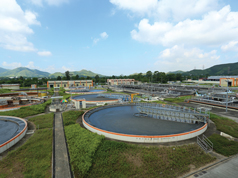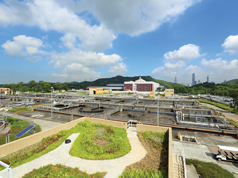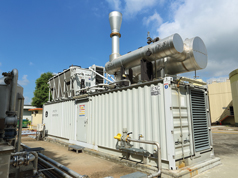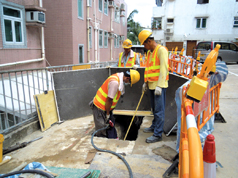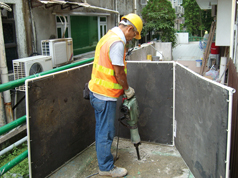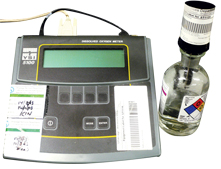Overview of Sewage Collection, Treatment and Disposal
Overview of Sewage Treatment and Sewerage System
Sewage Treatment plays a crucial role in our services for Hong Kong. By means of different types of treatment processes and advanced technologies, most of the pollutants, toxic materials and bacteria inside the sewage will be removed to a level meeting the environmental standards.
For the collection of sewage from the territory, we have developed a huge sewerage network with a total length of 1,683 kilometres, which is almost equivalent to the distance from Hong Kong to Jinan, Shandong. Our sewerage system is serving 93 per cent of the population in Hong Kong.
At present, we are operating 292 sewage treatment facilities, including 68 sewage treatment works (STW) and 224 sewage pumping stations. We treat about 2.74 million cubic metres of sewage collected from our sewerage network every day.
| Summary of Sewage Treatment Facilities and Sewerage Network | 2009-10 | 2010-11 | 2011-12 | 2012-13 |
|---|---|---|---|---|
| Annual sewage treatment volume (million m3) | 979 | 979 | 981 | 1,001 |
| Coverage of public sewerage (population percentage) | 93% | 93% | 93% | 93% |
| Total length of sewerage network (km) | 1,622 | 1,637 | 1,647 | 1,683 |
| Total no. of sewage treatment facilities | 277 | 284 | 287 | 292 |
In 2012-13, we treated 1,001 million cubic metres of sewage in total. 30.6 per cent of the sewage received Preliminary Treatment, 52.4 per cent received Chemically Enhanced Primary Treatment (CEPT), 16.5 per cent received Secondary Treatment and 0.5 per cent received Primary & Tertiary Treatment.
Annual Sewage Treatment Volume 1,001 million m3
Sludge is produced during the sewage treatment process. The total quantity of sludge collected in 2012-13 was 300,965 tonnes. It required 26,128 container vehicle trips to deliver the sludge for disposal at the landfills.
We have been properly maintaining our sewage collection, treatment and disposal facilities to ensure their efficient and effective operation. We will continuously improve the sewerage coverage and treatment facilities, enabling the sustainable development of Hong Kong.
Sewage Treatment Performance
Professional Laboratory Services
Strict quality compliance relies on the support from our professional laboratory services. Our Shatin Central Laboratory and Stonecutters Island Laboratory have gained accreditations since 1999 for testing of environmental samples (water & wastewater) under the Hong Kong Laboratory Accreditation Scheme (HOKLAS) operated by the Hong Kong Accreditation Services of the Innovation & Technology Commission. The number of tests accredited increased from seven to twenty in the period between 1999 to 2013. Six more tests in relation to trace metal are expected to be accredited in 2013-14. Stonecutters Island Laboratory has also gained accreditation since 2007 for testing of chemical samples to assure that the procured chemicals for sewage treatment are complying with the contract specifications.
Analytical Services
A comprehensive sampling scheme is in place to provide pollutant loading measurement and monitoring of treatment efficiencies at various treatment units. This is to ensure effluent is treated to meet mandated discharge license conditions and precise data are provided for quality compliance.
Extensive laboratory testing, which covers more than 14 types of analyses, has been carried out in our laboratories in Sha Tin, Tai Po, Sai Kung, Shek Wu Hui and Yuen Long. In 2012-13, the total number of analyses carried out by our laboratories was about 235,870. The analytical results of the effluent quality of major sewage treatment works can be found in our website (www.dsd.gov.hk).
Planning, Design and Construction of New Works
Harbour Area Treatment Scheme Stage 2A
The Harbour Area Treatment Scheme (HATS) aims to improve the water quality of Victoria Harbour by intercepting and treating sewage generated from both sides of the Harbour. HATS consists of two stages. Stage 1 was commissioned in December 2001 treating about 75 per cent of the sewage generated from both sides of the Harbour by chemically enhanced primary treatment. Stage 2 is divided into Stages 2A and 2B. The former is now in progress and will collect and treat the remaining sewage generated from Hong Kong Island's northern and southwestern regions before discharge. Stage 2A's major engineering works are anticipated to be completed in end 2014. The implementation programme of HATS 2B, which aims to add biological treatment to the effluent, is now being reviewed by Environmental Protection Department.
Feasibility Study on Relocation of Shatin Sewage Treatment Works to Caverns
Shatin Sewage Treatment Works (STW) is the largest secondary STW in Hong Kong. Its relocation to caverns could release the existing site of about 28 hectares for housing and other purposes that would enhance our living quality. This proposal will also help remove incompatible land uses with the surroundings and enhance the community and environment.
We commenced the feasibility study on relocation of Shatin STW to caverns in May 2012 for completion within about 24 months. After review, we have re-affirmed that Nui Po Shan of A Kung Kok is the most suitable relocation site for Shatin STW. We have preliminarily investigated the sewage and sludge treatment options suitable for the relocated Shatin STW inside caverns. To solicit comments and opinions from the public and stakeholders, we conducted the Stage 1 public engagement exercise between November 2012 and March 2013. We have substantially completed the preliminary impact assessments to address the public's concerns about the relocation proposal. We plan to conduct the Stage 2 public engagement exercise from July to October 2013 to share with the public the results of the preliminary impact assessments and the proposed mitigation measures to address their concerns.
To facilitate the understanding of the public and stakeholders on the benefits of housing a STW inside caverns, we have continued to arrange site visits for various parties to Stanley STW which is the first STW built in caverns in Hong Kong and has integrated well with the surrounding environment and community since its commissioning in 1995.
Further Expansion of Shek Wu Hui Sewage Treatment Works
Commissioned in 1984, the existing Shek Wu Hui STW provides secondary treatment to sewage collected from Sheung Shui, Fanling and the adjacent areas. In the coming years, Shek Wu Hui STW will reach its design capacity of 93,000 cubic metres per day. To cope with the forecast increase in sewage flow from the local neighbourhoods and the extension of public village sewerage, as well as the proposed new developments in Fanling North and Kwu Tung North, we plan to further increase the STW's capacity in phases. In order to ensure no increase in pollution load to Deep Bay, which is the ultimate discharge point of the effluent from Shek Wu Hui STW, the sewage treatment level of Shek Wu Hui STW will be upgraded progressively to tertiary level. To promote sustainable development, the upgraded STW will also provide an opportunity for possible re-use of effluent for toilet and other non-potable uses in Sheung Shui, Fanling and the new development areas. We have commissioned an investigation study in December 2012, the scope of which will cover design of sewage and sludge treatment process, various impact assessments, ground investigations, preparation of a preliminary design for the upgrading works, landscaping and greening plan, formulation of implementation strategies and programme, and public engagement for the further expansion of the STW. The investigation study is planned to be completed in mid-2014.
Extension of Public Village Sewerage
Over the years, we have been making efforts to extend public sewerage to more villages in order to improve the sanitary conditions of the unsewered villages and the water quality of the nearby streams and receiving water. At present, our village sewerage works at North District, Tai Po, Sha Tin, Yuen Long, Kam Tin, Tuen Mun, Tseung Kwan O, Sai Kung, and Outlying Islands are being carried out and are under different stages of planning, design and construction. Up to March 2013, we have completed public sewerage for over 150 villages while sewerage works for more than 80 villages are in progress. More than 230 villages are under planning and design stage for sewerage works.








